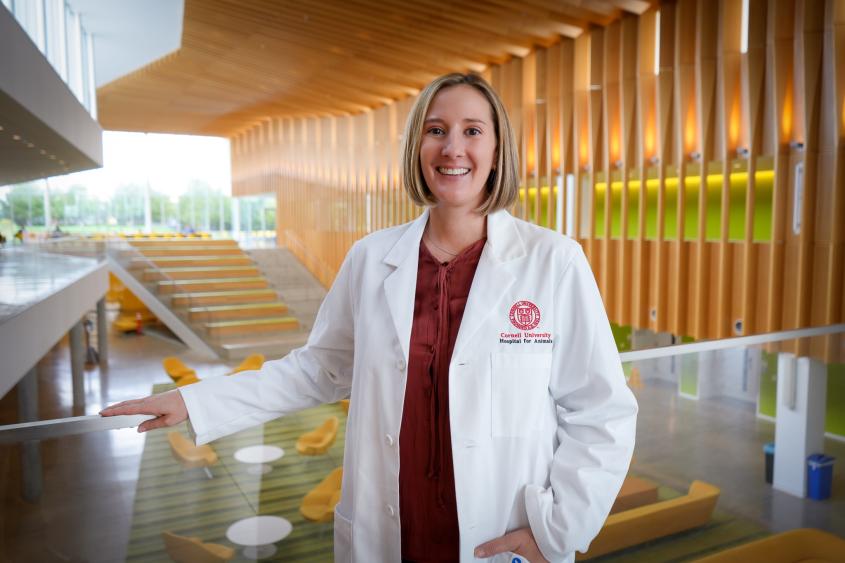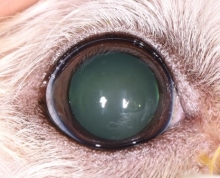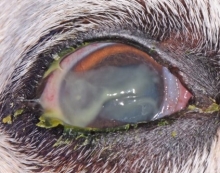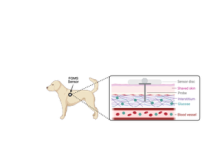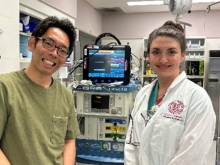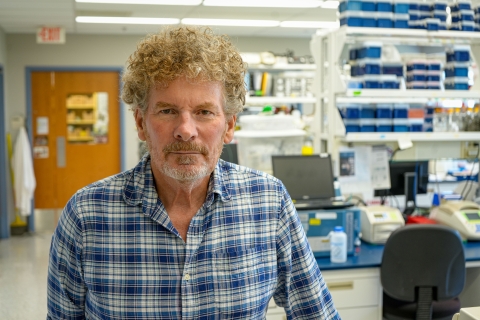The potential for advancements in canine research is greater than ever, and Cornell has a legacy of transformative contributions upon which we can build.
Cornell offers expertise from the very beginning of the research continuum — working from molecular-level discoveries to showing how these findings translate into real-world impact. By covering the full research process, we can test how our research applies to clinical settings — empowering our clinicians to perform cutting-edge medical advancements in our hospitals and clinics.
Explore how the Cornell Richard P. Riney Canine Health Center is investing in critical, innovative and collaborative research that will help dogs live longer, healthier, happier lives.
2024- 2025 Funded Research Projects:
Charting the Molecular Landscape of Canine Hemangiosarcoma: A Single-Cell and Spatial Omics Approach to Uncover New Diagnostic and Therapeutic Targets
Hemangiosarcoma is a deadly cancer that affects a significant number of dogs, posing a major challenge for veterinarians and pet owners alike. This cancer is notoriously complex because it consists of different types of cells, each behaving differently, which makes it hard to diagnose and treat effectively. Often the diagnosis is made well after the cancer (which often begins in the spleen) has metastasized (spread beyond the primary location of the cancer).
Danko’s research aims to tackle this complexity head-on by employing cutting-edge technologies that allow his group to examine each cell in a tumor individually. Danko will look into the genetic makeup and activity of these cells to understand their roles and how they interact within the tumor, similar to identifying the unique sounds of each instrument in an orchestra. A key focus will be on identifying the "lead instruments" — the stem cells believed to be central in the cancer's growth and spread. By pinpointing these cells and understanding how their behavior is encoded in their genomes, Danko’s work aims to uncover new ways to diagnose and treat hemangiosarcoma more effectively, bringing hope for better outcomes for our beloved pets. Danko’s work promises to provide unprecedented insights into the disease at a level of detail never seen before, opening the door to new diagnostic and treatment options.
Principal Investigator: Charles Danko, Associate Professor in Life Science and Technology
Metagenomic analysis of microbiological changes on the ocular surface of dogs with uncontrolled keratoconjunctivitis sicca (KCS)
The surface of the eye (cornea and conjunctiva) contains a diverse community of bacterial, fungal, and viral microorganisms – all of which cooperate to keep the eye surface healthy. Molecular-based tests use the unique genetic code of each organism’s DNA to identify eye surface microorganisms. Little is known about the community of microorganisms naturally living on the dogs’ eye and its role in either preventing harmful infections or contributing to disease.
We propose to evaluate the ocular microbiota of dogs with a common dry eye condition known as keratoconjunctivitis sicca (KCS) and compare our findings to the microbiota of normal dog’s eyes. Samples will be collected by swabbing the inside of the lower eyelid after a numbing eye drop is applied. DNA is then isolated and analyzed from these swabs.
This study will open avenues for continued research and advancements in the treatment of dry eye diseases. Dry eye disease is also a common problem of human eyes so any results may help the human condition too.
|
Normal Eye |
Diseased Eye |
Principal Investigator: Erin Scott, Associate Professor, Section of Ophthalmology
Accuracy of a Flash Glucose Monitoring System in Diabetic Dogs
Diabetes mellitus (diabetes) is a common illness in dogs which can be difficult to manage by your veterinarian and yourself at home. Treatment involves giving insulin by injection and checking blood sugar levels regularly.
A new system called the FreeStyle Libre 1 can measure glucose in dogs quickly and easily without needing to prick them repeatedly. This system uses small sensors placed on the dog's chest or hip to check sugar levels continuously. Many people find this helpful for managing their dog's diabetes and improving their quality of life.
The new Libre 3 model sends the sugar measurements automatically to a reader or smartphone, so you don't have to scan it regularly. This study aims to find out if the Libre 3 is accurate for measuring blood glucose in dogs, if using the Libre 3 would change insulin dosing instructions, and what owners think about using the Libre 3. We think the Libre 3 will give accurate readings and help vets give better treatment advice, ultimately improving life for diabetic dogs and their families.
Diabetes is a major problem is humans and similar continuously monitoring devices are already used. Why shouldn’t our canine family benefit too?
Principal investigator: Jennifer Prieto, Assistant Clinical Professor, Section of Small Animal Medicine
ATP Release Pannexin Channels are Potential Pain Biosensors for Dogs
Pain management is central to veterinary medicine; it is important not only from an ethical standpoint but also because analgesia has been shown to facilitate recovery from injury and disease. The major challenge is to properly assess the source, type, and the degree of pain for effective treatment.
Currently available analgesics like nonsteroidal anti-inflammatories (NSAIDs) often fail to work, especially for dogs with chronic pain, or pain caused by damaged or diseased nerves, substantially impacting quality of life and often leading to euthanasia. We will investigate a membrane channel called pannexin, a potential new pain biosensor/molecular target for developing a new analgesic.
Importantly in this study, clinical and basic laboratories will combine in a true translational research effort in order to understand clinical findings through fundamental discovery. Objective ground forces produced on force plates following TPLO surgery for ruptured cranial cruciate ligament (ACL) will be correlated with pannexin and other pain mediator level in the synovial fluid from their joints.
We will also develop a pannexin assay such that these canine samples could be potentially evaluated within a short period of time to be actionable in the point of care setting. Furthermore, our improved high-throughput assay will be an excellent tool to discover small molecules targeting this unique class of potential pain mediators. We expect such efforts may ultimately provide novel therapies for dogs suffering from chronic pain.
Principal Investigator: Toshi Kawate, Associate Professor of Molecular Medicine
Co-Investigator: Jordyn Boesch, Associate Clinical Professor, Section of Anesthesiology and Pain Medicine
A prospective, double-blind, randomized, placebo-controlled, clinical trial of bedinvetmab in dogs with naturally occurring elbow osteoarthritis
Elbow arthritis is a common cause of forelimb lameness and disability in dogs of all ages; the primary cause being a developmental disease called ‘elbow dysplasia’. Management of this arthritis, in its adult form, consists chronic administration of drugs (e.g. non-steroidal anti-inflammatories such as carprofen), weight management, supplements, and appropriate exercise. Despite all these interventions, many dogs continue to display lameness of the forelimbs.
Librela™ (bedinvetmab) is a new monthly injectable medication available for the treatment of dogs with arthritis. It is a monoclonal antibody that targets a nerve growth factor that contributes to the pain associated with arthritis. Company provided data shows that dogs seem to improve with administration of the medication. We aim to discover the degree and duration of improvement associated with this medication by collecting functional gait data over the course of six months of medication administration and comparing this to the same data in untreated dogs.
Principal Investigator: Ursula Krotscheck, Professor, Section of Small Animal Surgery
Understanding and Control of Epidemic H3N2 Influenza Viruses in Dogs
The burden of canine infectious respiratory disease complex (CIRDC) in dog populations is poorly understood. Multiple bacterial and viral pathogens contribute to the disease in dogs, with no clear understanding of transmission dynamics and contributions between the causes.
While vaccines exist for some, the efficacy of these preventatives and therapies are not known without analysis of the pathogens and their evolution in dogs. The influenza virus introduced into the USA in 2015 has continued to circulate widely and cause large outbreaks in the USA and Canada and has also continued to spread in China. Since 2017 outbreaks around the US have been associated with new lineages of virus, some likely originating in China, and those continue to circulate widely.
It appears superficially that the H3N2 canine influenza virus is causing more sustained and dispersed outbreaks of disease around the US. The work in this project seeks to match the CIV disease transmission and the nature of the outbreaks to basic biological properties of the virus in the laboratory. It further will examine whether the vaccine virus differs from contemporary strains in its antigenic structure, impacting protection to dogs. A primary goal is to develop strategies to intervene in transmission and eradicate the H3N2 CIV, removing one key player currently causing the high CIRDC burden in dog populations.
Principal Investigator: Colin Parrish, John M. Olin Professor of Virology
Defining the molecular landscape of canine granulomatous colitis to inform prevention and treatment
Canine granulomatous colitis (GC) is a severe inflammatory bowel disease (IBD) that mostly affects young Boxer and French Bulldogs. Signs of the disease include chronic diarrhea accompanied by loss of weight and muscle mass. The Simpson Lab performed groundbreaking work to discover the disease is caused by invasive intestinal bacteria called E. coli, which can be treated with antibiotics.
Unfortunately, many affected dogs are increasingly infected with E. coli that are resistant to antibiotics and go on to suffer chronic illness that is fatal. It is very important to understand the detailed molecular processes that lead to the disease in order to be able to develop new and effective drugs that can improve quality of life or even cure the disease completely.
The Sethupathy lab has made key observations recently about the role of a special class of molecules, called micro(mi)RNAs, as drivers of disease in human IBD that resembles canine GC. As it has in the case of human IBD, the study of miRNAs and their roles in the canine intestine could reveal key insights into how GC develops and progresses, which in turn would offer new strategies for drug development.
Together the partnership between Sethupathy and Simpson is poised to break new ground in the field of canine GC research and potentially pave the way for new prognostic, preventative and therapeutic measures.
Investigator: Praveen Sethupathy, Professor of Physiological Genomics
Investigator: Kenneth W. Simpson, Professor, Section of Small Animal Medicine




